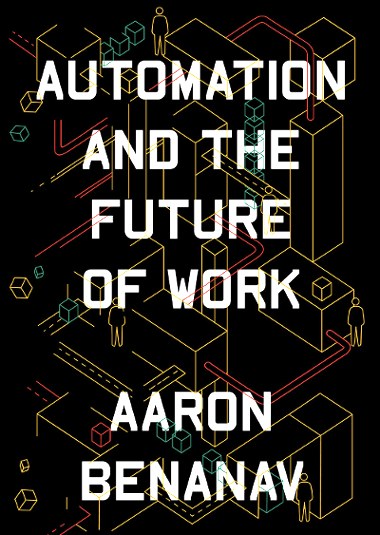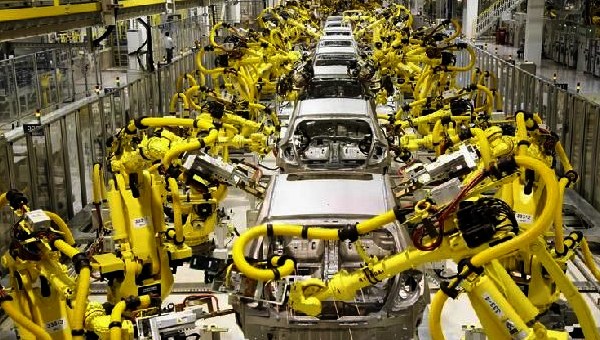Post-Capitalist Futures? Work After Automation
Widespread social concern about potentially negative consequences of technological automation for workers is nothing new. Since the era of early industrialism, commentators and economists have mused about the potentially damaging effects of technological change that augments and displaces human with machine labour. Mid-19th century theorists like Charles Babbage, John Adoplhus Etzler and, and Andrew Ure envisioned the coming of fully automated industrial factories, where human labour would be reduced to a supervisory and maintenance role. Marx believed automation had the potential to de-skill and permanently replace human labour. In one memorable passage, Marx highlights the destructive potential of the sewing machine, arguing that in the 19th century textile industry when other exploitative methods for obtaining surplus value had reached a natural limit,
“The hour of the machine had struck. The decisively revolutionary machine, the machine which attacks in an equal degree all the innumerable branches of this sphere of production, such as dressmaking, tailoring, shoemaking, sewing, hat-making and so on, is the sewing machine.” (Marx, Capital, 1867, p.601)

This ‘automation anxiety’, as economist David Autor has dubbed it, has resurfaced at different moments in the history of capitalism, for a variety of reasons, usually as an explanation for structural shifts in capitalist labour markets. In the early postwar period, high levels of economic growth intertwined with technical changes in the capital-intensive system of Fordist mass production created fears that rising levels of productivity might outstrip the demand for labour. Following the stagflation crisis of the 1970s and the end of the postwar economic boom, social democratic and progressive thinkers maintained that continued economic stagnation in the core capitalist countries was the result of a ‘skills mis-match’ between labour and the technical conditions of production in the emerging new information technologies.
Automation Anxiety
The 2008 Financial Crisis, long-term secular stagnation, the rise of monopolistic tech giants, and the emergence of the gig economy has provided the backdrop for the most recent wave of automation anxiety centred on the disruptive potential of Artificial Intelligence (AI) technologies. New breakthroughs in AI suggest that not only would 21st century automation augment human labour to a significant degree, as it always has, but self-directed intelligence would have an unprecedented ability to replace labour altogether. This fear was crystallized in in an influential 2013 paper by Oxford economists Carl Benedikt Frey and Michael Osborne in which they predicted that AI would lead to the replacement of 47 per cent of jobs in the US labour market in the near future.
In their widely read Second Machine Age (2014), Erik Brynjolfsson and Andrew McAfee further argued that developments in AI would weaken demand for labour, create widespread technological unemployment, and empower a new rentier class. On the left, writers on the future of capitalism like Nick Srnicek and Alex Williams (2015), as well as Peter Frase (2016), similarly see the destructive tendencies of the new wave of automation, but also see in the digital economy positive transformative potential in transcending the drudgery of work and the constraints of material scarcity under capitalism. Indeed, these authors maintain that automation should be at the centre of socialist strategy as the basis of a new socialist society.
Critique of Automation Theory
It is within this intellectual terrain that Automation and the Future of Work by Aaron Benanav (Verso, 2020) makes its contribution. The book presents a sympathetic critique of automation theory and in particular the notion of widespread technological unemployment resulting from AI-based automation. Automation theorists contend that as productivity continues to rise, induced by technological advancements, there is a decline in long-term employment. This leads to technological unemployment and, in turn, to several knock-on effects: a declining share of income going to labour, reduced consumption, rising inequality, widespread unemployment, and other dislocations. Benanav maintains, however, that this automation narrative fails to adequately distinguish productivity (a ratio of overall production volumes to employment) to the growth rate of real output (how much is produced overall) in its calculations.
From the immediate postwar period until the stagflation crises of the 1970s, rapid rates of productivity were outpaced by growing real output, inducing further investment and employment in a virtuous – often termed Fordist – growth cycle. The cycle broke down in the 1970s when across the advanced capitalist states the pace of productivity declines was exceeded by an even greater drop-off of output growth even while the labour force continued to grow. This might suggest the influence of automation in any particular sector (that is, falling employment volumes while output continues to increase), if it was not for the fact that overall productivity has been declining compared to its postwar heights alongside real output declines suggesting wider structural economic problems beyond automation for labour market insecurities.
The implication Benanav draws is that it could not be rapid advances in productivity causing mass unemployment and economic stagnation. Instead, deteriorating levels of output are causing lagging productivity gains as opposed to the other way around, essentially turning the automation thesis on its head. The real cause of this process of “output-led deindustrialization” stems from increased global competition within the manufacturing sector beginning in the 1970s. In making this argument Benanav draws upon the work of Marxist economist Robert Brenner, who argues in The Economics of Global Turbulence (1998) and elsewhere that contemporary Western economies are experiencing a ‘long downturn’ as a result of ‘overcapacity’ in the manufacturing sector. In short, the contention is that the development of advanced manufacturing capacity first across Western and then developing states led to a decline in output growth among previously dominant US firms who now had to compete with low-cost producers all over the world. This created a situation of competitive bidding down of the prices for manufactured goods. Depressed prices produced falling rates of profit and reduced industrial investment, leading to lower output and, eventually, economic stagnation.
This explains why output growth declined more rapidly than productivity: firms would necessarily have to become more productive in order to survive, but nonetheless their output continued to deteriorate in an environment of intense international competition. This also explains the appearance (at least) of rapidly advancing automation and technological unemployment, as international competition induces firms to adopt the latest productive technology. Crucially, however, this competitive automation is only a symptom of the greater underlying issue of manufacturing overcapacity in the global political economy.
This account of the trajectory of postwar capitalism, however, has its limitations. Benanav deals with the financialization of Western economies during this period expeditiously as a similar corollary of manufacturing overcapacity: capital investment has no place to go and resorts to speculative activity on an increasing scale. The role of the state is dealt with in equal haste, conceived largely as epiphenomenal in relation to the imperatives of market competition and the power and movement of capital. Benanav overlooks the extent to which advanced capitalist governments were key players in engineering financialized capitalism by initiating transformations in monetary policy, bank regulation, and the legalization of new financial products and technologies. State-backed Financialization may be less a by-product of depressed levels of investment and secular stagnation and more a source of these dynamics, as investors and firms seek to exploit new opportunities within a changing legal and institutional environment fostered by policymakers and central banks and, in doing so, withdraw capital from more productive and labour-intensive industrial activity.
Whatever the cause, however, the fears of contemporary automation leading to long-term secular unemployment are misplaced. This is especially true in light of the recent history of Western economies which were in the process of steadily lowering their unemployment rates toward ‘full-employment’ levels pre-pandemic, and almost four decades after information and communication technologies began to be systematically introduced into industry. Much of this new-found employment, however, was part-time, precarious, and taken-up under deteriorating conditions; suggesting the impact of automation is felt less at the macro-level in terms of aggregate employment and more at the level of everyday class struggle within the workplace, as it is used to deskill the work process and weaken the bargaining position of labour. The dynamics of class struggle, and the role of technology/automation within it (as, for example, Braverman demonstrated in his classic work Labor and Monopoly Capital), is strangely absent from Benanav’s account.
Role of Class
Class antagonisms are much more front-and-centre in the book’s critique of some of the proposed solutions – often in the form of ‘silver bullets’ – to the perceived crisis of automation. Benanav dismisses Keynesian solutions in the form of either traditional fiscal stimulus or increasingly popular universal basic income (UBI) proposals. The argument against both is that they will do little to revive growth under conditions of globalized capitalist competition in which the key issue is not the availability of capital or lack of demand, but the willingness of capital to invest under conditions of industrial overcapacity. In fact, the historical trajectory of Western states serves as a testament to this, according to Benanav, as Keynesian-style countercyclical spending did not begin in earnest until the 1970s after the neoliberal turn of advanced capitalist economies.
Moreover, ‘zero-bound’ interest rates and quantitative easing following the financial crisis have failed to lift these economies out of long-term secular stagnation following the financial crisis, contrary to much of Keynesian thinking. What is needed is the socialization of investment to orient production toward real full employment and away from profit-seeking. While capitalists have historically been willing to live with traditional social democratic full employment objectives, they have fought against public control over investment tooth-and-nail, largely because it challenges capital’s main source of structural power over states: the capital strike. This cannot be accomplished through fiscal and monetary tools alone – the “conquest of production” through class struggle is required.

Post-Capitalist Society?
In the final chapter of the book, “Necessity and Freedom,” Benanav outlines a self-consciously utopian vision of post-capitalist society. In contrast to automation theorists, who presuppose a teleological trajectory of technological development toward complete automation to which society must either slavishly adapt or revolutionize, Benanav returns to the classic utopian tradition of More, Cabet, Marx and others to argue that what is essential is to transform society’s system of production away from profit toward human dignity, self-realization, and life-making. As opposed to visons of “fully automated luxury communism” (e.g. Bastani 2019), post-scarcity will be achieved not from technological development, but from a cooperative system of production that would replace market competition. Within such a system, ‘necessary’ labour that furnishes the basic conditions of existence (e.g. the provision of housing, production of food, healthcare, education, etc.) would be more widely shared, with each individual dedicating some part of their time to this process of necessary social reproduction, and thereby breaking down the pernicious gender effects of labour across the ‘public/private’ divide. With necessary work more equally divided there can be a greater amount of free time more equally distributed in which individuals are able to seek self-fulfilment. Technology would be embedded in this cooperative system as much as it is embedded in capitalism and would serve not the needs of capital but facilitate the planning of production, assist in socially beneficial work, and do away with the most arduous, unpleasant forms of necessary labour.
While Benanav’s vision of post-capitalist, post-scarcity system is indeed appealing, it has much less to say in how socialists might intervene in capitalism as it exists today to achieve the egalitarian society of the future. In the postscript Benanav places his hopes on the new social movements that have emerged globally in the decade following the global financial crisis as key “agents of change” toward a post-scarcity future. He speaks approvingly of the communal aspects of such movements, which have demonstrated spontaneous forms of cooperative social reproduction and communal care. But it is not clear how these disparate movements and causes move from necessary but specific campaigns and struggles to coalescing around a political project for transcending capitalism. Like his analysis of the postwar trajectory of capitalist political economies, Benanav’s reading of the potential roads to socialism fails to address how to transform the capitalist state and the obstacle it presents for socialist strategies. To paraphrase Andre Gorz in his famous essay “Reform and Revolution,” small islands of socialism are too easily isolated in a vast ocean of capitalism. What is needed are the types of transformative reforms capable of penetrating and rupturing the structural power and social hegemony of capital from within the state itself.
This, in turn, requires us to consider the crucial role of political parties, mass electoral politics, and social movements in forming a political bloc dedicated to democratization of the state and capital. This revolutionary process cannot simply be a matter of a socialist party with the right policies forming government, but requires the democratization of the state itself. The latter entails seizing and transforming the means of administration into a genuinely public space in which workers and communities form participatory councils to determine social provisioning and administer public resources in an on-going, consistent, and meaningful manner. Crucial to this task is building the capacities of individuals for true democratic participation and self-governance, a critical pedagogical process that would occur first within socialist parties and organizations and continue within the institutions of the state itself. But democratic capacity building is more assumed than strategized in Benanav’s system of cooperative production. Radically re-drawing the capitalist division of labour in a manner that would more equally divide necessary and free labour will require a vast, sustained effort of retraining that could only be accomplished through extending democratic planning over the state and its educational institutions. The ability and skills of self-governance, moreover, could only come through a similarly long process of learning through participation in popular institution building.
Building the skills and governance capacities of workers is integral to meeting the ceaseless processes of capitalist automation. The constant displacement of labour by more capital in any given sector and employment does not inexorably lead to widespread general technological unemployment as new sectors and employment are also constantly being created. But work and workers are constantly being deskilled and degraded under capitalism – the new machines and technologies are always as much about control and discipline as about productivity increases. Education and training systems, especially for the working class and the most marginalized communities, mirror the processes of accumulations and seek to compartmentalize skill formation into industry and technology-specific ‘competencies’ rather than develop comprehensively the theoretical, practical self-management skills and capacities of the workforce. In order to shift future technological development in a more egalitarian direction, workers as individuals and as a class must be emboldened with the broad skills and cognitive capacities to think through and control the labour process, including its managerial aspects. Automation in itself will not lead us to either political utopias or dystopias outlined by these opposing prophets. Democratic controls over automation will remain, as this valuable book from Benanav suggests, an integral dynamic of capitalist class struggle. •





